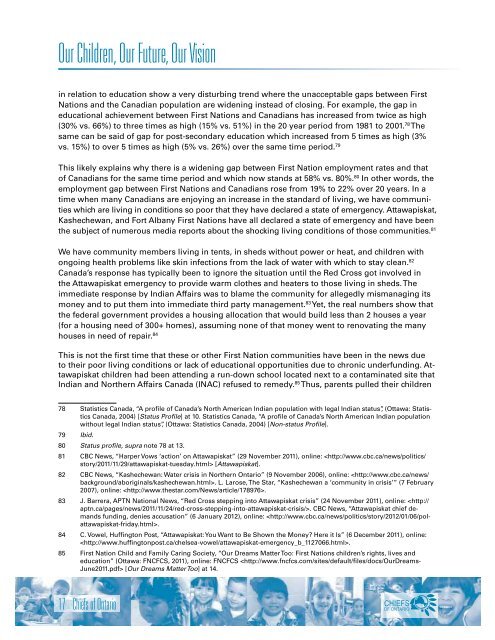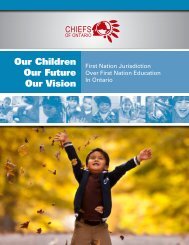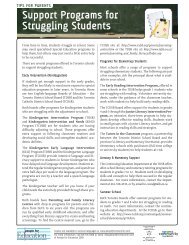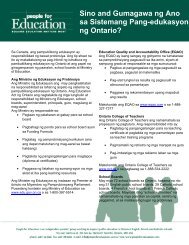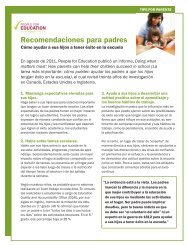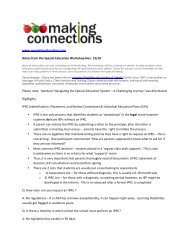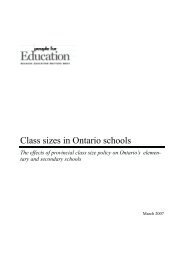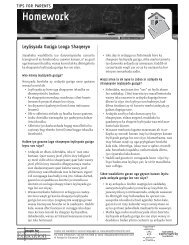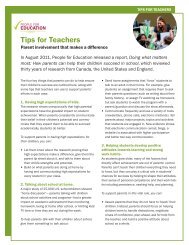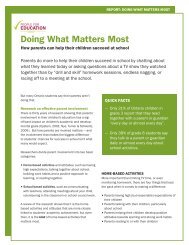Our Children Our Future Our Vision - People for Education
Our Children Our Future Our Vision - People for Education
Our Children Our Future Our Vision - People for Education
Create successful ePaper yourself
Turn your PDF publications into a flip-book with our unique Google optimized e-Paper software.
<strong>Our</strong> <strong>Children</strong>, <strong>Our</strong> <strong>Future</strong>, <strong>Our</strong> <strong>Vision</strong><br />
in relation to education show a very disturbing trend where the unacceptable gaps between First<br />
Nations and the Canadian population are widening instead of closing. For example, the gap in<br />
educational achievement between First Nations and Canadians has increased from twice as high<br />
(30% vs. 66%) to three times as high (15% vs. 51%) in the 20 year period from 1981 to 2001. 78 The<br />
same can be said of gap <strong>for</strong> post-secondary education which increased from 5 times as high (3%<br />
vs. 15%) to over 5 times as high (5% vs. 26%) over the same time period. 79<br />
This likely explains why there is a widening gap between First Nation employment rates and that<br />
of Canadians <strong>for</strong> the same time period and which now stands at 58% vs. 80%. 80 In other words, the<br />
employment gap between First Nations and Canadians rose from 19% to 22% over 20 years. In a<br />
time when many Canadians are enjoying an increase in the standard of living, we have communities<br />
which are living in conditions so poor that they have declared a state of emergency. Attawapiskat,<br />
Kashechewan, and Fort Albany First Nations have all declared a state of emergency and have been<br />
the subject of numerous media reports about the shocking living conditions of those communities. 81<br />
We have community members living in tents, in sheds without power or heat, and children with<br />
ongoing health problems like skin infections from the lack of water with which to stay clean. 82<br />
Canada’s response has typically been to ignore the situation until the Red Cross got involved in<br />
the Attawapiskat emergency to provide warm clothes and heaters to those living in sheds. The<br />
immediate response by Indian Affairs was to blame the community <strong>for</strong> allegedly mismanaging its<br />
money and to put them into immediate third party management. 83 Yet, the real numbers show that<br />
the federal government provides a housing allocation that would build less than 2 houses a year<br />
(<strong>for</strong> a housing need of 300+ homes), assuming none of that money went to renovating the many<br />
houses in need of repair. 84<br />
This is not the first time that these or other First Nation communities have been in the news due<br />
to their poor living conditions or lack of educational opportunities due to chronic underfunding. Attawapiskat<br />
children had been attending a run-down school located next to a contaminated site that<br />
Indian and Northern Affairs Canada (INAC) refused to remedy. 85 Thus, parents pulled their children<br />
78 Statistics Canada, “A profile of Canada’s North American Indian population with legal Indian status”, (Ottawa: Statistics<br />
Canada, 2004) [Status Profile] at 10. Statistics Canada, “A profile of Canada’s North American Indian population<br />
without legal Indian status”, (Ottawa: Statistics Canada, 2004) [Non-status Profile].<br />
79 Ibid.<br />
80 Status profile, supra note 78 at 13.<br />
81 CBC News, “Harper Vows ‘action’ on Attawapiskat” (29 November 2011), online: [Attawapiskat].<br />
82 CBC News, “Kashechewan: Water crisis in Northern Ontario” (9 November 2006), online: . L. Larose, The Star, “Kashechewan a ‘community in crisis’” (7 February<br />
2007), online: .<br />
83 J. Barrera, APTN National News, “Red Cross stepping into Attawapiskat crisis” (24 November 2011), online: . CBC News, “Attawapiskat chief demands<br />
funding, denies accusation” (6 January 2012), online: .<br />
84 C. Vowel, Huffington Post, “Attawapiskat: You Want to Be Shown the Money? Here it Is” (6 December 2011), online:<br />
.<br />
85 First Nation Child and Family Caring Society, “<strong>Our</strong> Dreams Matter Too: First Nations children’s rights, lives and<br />
education” (Ottawa: FNCFCS, 2011), online: FNCFCS [<strong>Our</strong> Dreams Matter Too] at 14.<br />
17 Chiefs of Ontario


